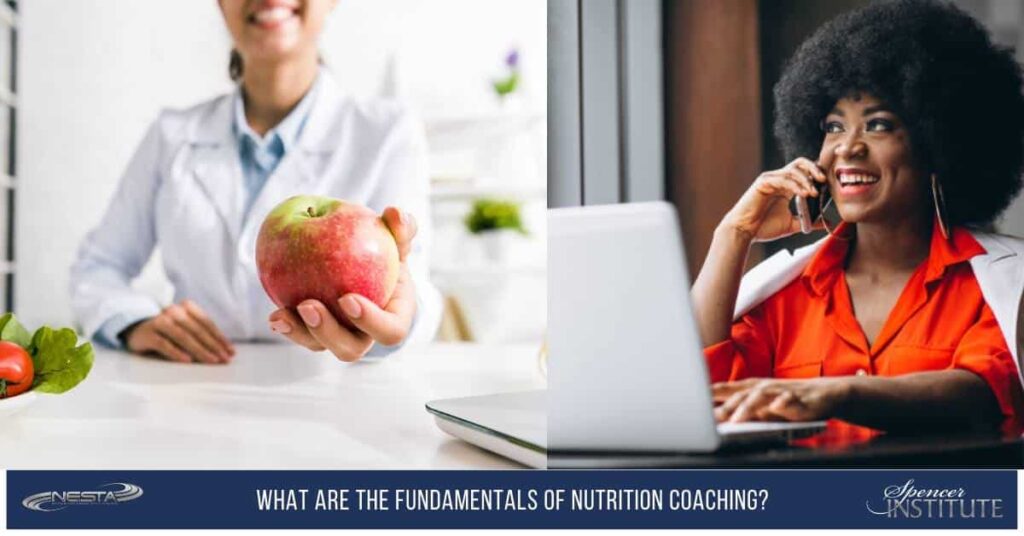 The primary goal for this course is to promote optimal health through applied nutrition science. For fitness professionals, it’s virtually impossible to work toward this goal without considering information about nutrition and exercise together. For the typical client that we work with or train, this could include determining the appropriate food, fluids, and supplements required for various training or environmental conditions.
The primary goal for this course is to promote optimal health through applied nutrition science. For fitness professionals, it’s virtually impossible to work toward this goal without considering information about nutrition and exercise together. For the typical client that we work with or train, this could include determining the appropriate food, fluids, and supplements required for various training or environmental conditions.
For most individuals, it likely means that there will be some learning toward a goal of eating to promote basic, good health, to maintain (or lose) weight, and fuel the demands of the body when exercising. Regardless of fitness or exercise goals, sound nutrition improves exercise performance for most healthy individuals, decreases recovery times from strenuous exercise, prevents exercise-associated injuries from fatigue, provides the fuel required during high-intensity training, and helps to control weight. So there is a lot to get correct with respect to clients, because their success may depend on reaching optimal health goals. If we fail to support their goals, is it a reflection of our abilities as a trainer or coach? For some it will be based on success with combining good nutrition with exercise. And we know through research that this combination can also help reduce the risk of numerous chronic diseases such as diabetes, cardiovascular disease, hypertension, obesity, osteoporosis, and some cancers.
Even more important, physicians often recommend nutrition and physical activity to treat individuals who already have these known chronic conditions and diseases.
Understanding how nutrition and exercise work together in support of optimal health is essential for health, nutrition, and fitness professionals responsible for teaching others how to maintain the benefits of good health and to reduce risks of chronic disease. Our opening lesson is therefore focused on the various guidelines and resources that trainers, coaches, nutritionists, and dietitians use to scientifically evaluate dietary intakes for their client. Taking things one step further, we then work to understand how we would determine an individual’s nutrient and energy requirements. Knowing some general guidelines will support learning that occurs in subsequent lessons. Guidelines applied when coaching active individuals, athletes, or clients are simply modifications—specific to the individual, activity, and even the environment—of these general nutrition recommendations.
Nutrition and Exercise
Most of the research used for this – and many similar programs – has zeroed in on evaluating the role of nutrition in exercise and fitness. As you could probably guess, a lot has emerged in a relatively short period – and has resulted in changes for how teaching the science of nutrition is accomplished as well. In other words, new learners are getting the latest research and this is how our industry continues to move forward. The interest in learning nutrition beyond basics seems to be increasing significantly – and shows no sign of easing up. But doesn’t that make sense given demographics in our world today? In other words, there are more Baby Boomers among us – and this generation was the first to take a deeper interest in their health and wellness. This is also the first generation to benefit from the research done with respect to nutrition and exercise.
There is no doubt that nutrition plays a vital role in exercise performance and training. Macronutrients like carbohydrates are important for exercise performance and high-intensity training in ways that are different than carbohydrate metabolism for basic physiological function … or for the recovery from a bout of exercise. What about fluid intake? Wouldn’t it be important for us to understand the role that fluid intake and hydration play in short bursts of activity or endurance-based exercise?
There is plenty of evidence to show how athletes can benefit from the proper balance of energy, nutrient, and fluid intake. Targeting nutrition principles and variables can also help exercisers (at any level of experience) recover from strenuous physical activity. When we pair refueling with proper hydration for our client’s body, we can enable them to perform their best. In terms of recovery, if we provide advice on the nutrients needed to build and repair muscles, we enable clients to re-engage in their next bout of physical activity – ideally, with minimal adverse effects. This is especially important for athletes who participate in competitions or tournaments. In general, if your client engages in strenuous physical activity on a daily or more than daily basis, they fall into this group – for example, an ironman athlete who starts their day with a 60-minute swim workout and follows up with a long distance cycle workout in the afternoon. Between the two very different workouts, the athlete must recover.
This is done by replenishing the body’s glycogen stores and allowing for the repair of muscle tissues. In addition, adequate fluid levels must support optimal exercise performance.
We also need a way to assess food intake and fitness levels so that our professional recommendations can be relevant for each client. Ultimately, most nutrition advice you give active clients must consider all of these factors.
Well-fueled and hydrated athletes are better prepared for physical activity and are therefore able to reduce their risk of injury during exercise. As you may know, this risk of injury increases as an exercisers experiences fatigue and concentration problems emerge as they deplete the substrates that fuel their activity. Consider a client who is “dieting.” They may experience a lack of energy and nutrients needed to fuel their activity. Could this client also experience an injury if they are not fueled properly? The right nutrition strategies also aid in the healing processes required by injured participants or clients. The recovery from musculoskeletal injuries requires extra energy and nutrients. Some of the chapters that follow will look closer at the role that nutrients play in exercise and the issue of whether exercise increases the need for specific nutrients.
Health and fitness professionals already know that nutrition plays a key role in maintaining proper body weight and body composition (fat mass versus lean mass). Through their experiences, they also know that the typical client profile – one that includes losing weight – is marked by a dislike of one’s weight or shape and these alone are more appearance-based values. The role of the Fitness Nutrition Coach (FNC) then, must address ways to help the client understand more than the appearance angle. While important, a realistic strategy toward the control of their metrics has to be the primary concern when paired with your coaching service.
In pursuit of shaping one’s body in a bodybuilding competition, for example, it is normal to see extremes for losing weight, but it is done for a different reason. This cannot be confused with the basic health goals your typical client has for controlling body weight. The FNC has to be concise in their language when discussing nutrition with the client. The same tenets of communication used in trainer/client relationships apply for nutrition coaching. When done properly, it results in better outcomes. Rapport, honesty, and direct communication also factor in here.
What about clients who have significant concerns about their body weight or body image? If this concern becomes too powerful for our client, they can easily become overwhelmed to a point of obsessive behaviors or distorted thinking. This is an individual who may be at increased risk for disordered eating.
If not addressed, more serious eating disorders can become clinical in severity. We will define the populations you are able to work with and teach you the information you will need to apply in the field.
Increased interest in nutrition means that a lot of the products claiming to lead to improved exercise performance, gains in muscle strength, quick weight loss, and changes in body composition continue to increase and this can make it hard to separate fact from fiction. It seems that it’s impossible to flip through tertiary sources – which are offered in abundance as fitness, nutrition, or health magazines — without seeing an onslaught of advertisements for nutrient supplements, ergogenic aids, and other foods specifically for sports performance. If our clients get the message combined with the multiple advertisements for weight loss or gain, it is easy to see how the general public can become confused and distrustful of “nutritionists.”
Since nutrition and exercise research on supplementation is still relatively recent, a lot of questions remain. We still aim to inform you on ways that you can properly evaluate nutrition supplements and ergogenic aids for the claims they make.






